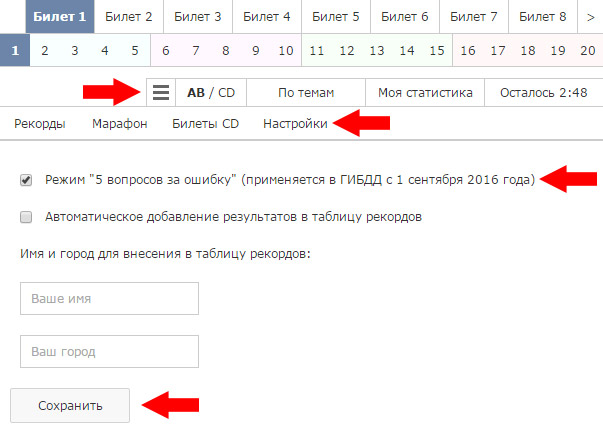Matanalysis is the limit of function. Limit theory
Type and species uncertainties are the most common uncertainties that need to be disclosed when solving limits.
Most of the tasks to the limits that come across students, just carry such uncertainties. For their disclosure or, more precisely, avoiding uncertainties, there are several artificial techniques for transforming the type of expression under the limit sign. These methods are as follows: the division of the numerator and denominator by the highest degree of the variable, multiplication by the conjugate expression and factorization for subsequent reduction using solutions of quadratic equations and formulas of abbreviated multiplication.
Species uncertainty
Example 1
n is equal to 2. Therefore, divide the numerator and the denominator by:
 .
.
Comment on the right side of the expression. Arrows and numbers indicate what the fraction seeks after substitution instead of n infinity values. Here, as in example 2, the degree n there is more in the denominator than in the numerator, as a result of which the whole fraction tends to an infinitesimal value or "super small number".
We get the answer: the limit of this function for a variable tending to infinity is equal.
Example 2 .
Decision. Here is the highest degree x equals 1. Therefore, we divide terminately the numerator and denominator by x:
Commentary on the course of the decision. In the numerator, we drive the “X” under the root of the third degree, and so that its initial degree (1) remains unchanged, assign it the same degree as the root, that is 3. The shooter and additional numbers are no longer in this record, so try mentally, but by analogy with the previous example, to determine what expressions in the numerator and denominator tend to after substituting infinity instead of "x".
We got the answer: the limit of this function for a variable tending to infinity is zero.
Species uncertainty
Example 3Uncover uncertainty and find the limit.
Decision. In the numerator is the difference of cubes. We decompose it into factors, using the formula of abbreviated multiplication from the course of school mathematics:
In the denominator is the quadratic trinomial, which we factor by solving the quadratic equation (once again, reference to the solution of quadratic equations):

We write down the expression obtained as a result of the transformations and find the limit of the function:

Example 4 Uncover uncertainty and find the limit
![]()
Decision. The quotient limit theorem is not applicable here, since
![]()
Therefore, we transform the fraction identically: multiplying the numerator and denominator by the binomial conjugate to the denominator, and reduce by x +1 According to the corollary of Theorem 1, we obtain an expression, solving which, we find the desired limit:

Example 5 Uncover uncertainty and find the limit
Decision. Direct Substitution x \u003d 0 into a given function leads to an uncertainty of the form 0/0. To reveal it, we perform the identical transformations and get the desired limit as a result: 
Example 6 Calculate ![]()
Decision: we use the limit theorems
Answer: 11
Example 7 Calculate ![]()
Decision: in this example, the limits of the numerator and denominator for are 0:
; ![]() . Therefore, we obtained the theorem on the limit of the quotient cannot be applied.
. Therefore, we obtained the theorem on the limit of the quotient cannot be applied.
We decompose the numerator and denominator into factors to reduce the fraction by a common factor tending to zero, and, therefore, make it possible to apply Theorem 3.
We decompose the square trinomial in the numerator according to the formula, where x 1 and x 2 are the roots of the trinomial. By factoring and the denominator, we reduce the fraction by (x-2), then we apply Theorem 3.
Answer:
Example 8 Calculate
Decision: When the numerator and denominator tend to infinity, therefore, when applying Theorem 3 directly, we get an expression that represents uncertainty. To get rid of the uncertainties of this kind, the numerator and denominator should be divided into the highest degree of the argument. In this example, you need to divide by x:

Answer:
Example 9 Calculate ![]()
Decision: x 3:

Answer: 2
Example 10 Calculate ![]()
Decision: When the numerator and denominator tend to infinity. Divide the numerator and denominator by the highest degree of the argument, i.e. x 5:
= 
the numerator of the fraction tends to 1, the denominator to 0, so the fraction tends to infinity.
Answer:
Example 11 Calculate
Decision: When the numerator and denominator tend to infinity. Divide the numerator and denominator by the highest degree of the argument, i.e. x 7:

Answer: 0
Derivative.
The derivative of the function y \u003d f (x) with respect to the argument xthe limit of the ratio of its increment y to the increment x of the argument x is called when the increment of the argument tends to zero:. If this limit is finite, then the function y \u003d f (x)is called differentiable at the point x. If this limit exists, then they say that the function y \u003d f (x) has an infinite derivative at x.
Derivatives of basic elementary functions:
1. (const) \u003d 09. ![]()
3. 11. ![]()
4. ![]() 12.
12. ![]()
Differentiation rules:
a) ![]()
Example 1 Find the Derived Function ![]()
Decision: If we find the derivative of the second term according to the fraction differentiation rule, then the first term is a complex function, the derivative of which is found by the formula:
Where ![]() then
then

When solving, the formulas were used: 1,2,10, a, c, d.
Answer:
Example 21 Find the Derived Function ![]()
Decision: both terms are complex functions, where for the first,, and for the second,, then
Answer: ![]()
Derivative Applications.
1. Speed \u200b\u200band acceleration
Let the function s (t) describe position object in some coordinate system at time t. Then the first derivative of the function s (t) is instantaneous speed object:
v \u003d s ′ \u003d f ′ (t)
The second derivative of the function s (t) is the instantaneous acceleration object:
w \u003d v ′ \u003d s ′ ′ \u003d f ′ ′ (t)
2. Tangent equation
y − y0 \u003d f ′ (x0) (x − x0),
where (x0, y0) are the coordinates of the tangent point, f ′ (x0) is the value of the derivative of the function f (x) at the tangent point.

3. Normal equation
y − y0 \u003d −1f ′ (x0) (x − x0),
where (x0, y0) are the coordinates of the point at which the normal is drawn, f ′ (x0) is the value of the derivative of the function f (x) at a given point.
4. Function increase and decrease
If f (x0)\u003e 0, then the function increases at the point x0. In the figure below, the function is increasing at x
If f (x0)<0, то функция убывает в точке x0 (интервал x1

5. Local function extremes
The function f (x) has local maximum at x1 if there exists a neighborhood of x1 such that f (x1) ≥f (x) for all x from this neighborhood.
Similarly, the function f (x) has local minimum at x2 if there exists a neighborhood of x2 such that f (x2) ≤f (x) for all x from this neighborhood.
6. Critical points
Point x0 is critical point function f (x) if the derivative f ′ (x0) in it is equal to zero or does not exist.
7. The first sufficient sign of the existence of an extremum
If the function f (x) increases (f ′ (x)\u003e 0) for all x in a certain interval (a, x1] and decreases (f ′ (x)<0) для всех x в интервале и возрастает (f′(x)>0) for all x from the interval $
| Example 3 |
| Solve $ \\ lim \\ limits_ (x \\ to -1) \\ frac (x ^ 2-1) (x + 1) $ |
| Decision |
|
As always, we start by substituting the value of $ x $ into the expression under the limit sign. $$ \\ lim \\ limits_ (x \\ to -1) \\ frac (x ^ 2-1) (x + 1) \u003d \\ frac ((- 1) ^ 2-1) (- 1 + 1) \u003d \\ frac ( 0) (0) $$ What's next next? What should be the result? Since this is uncertainty, this is not the answer and continue the calculation. Since we have a polynomial in the numerators, we decompose it into factors, using the familiar formula from the school bench $$ a ^ 2-b ^ 2 \u003d (a-b) (a + b) $$. Remembered? Fine! Now go ahead and apply it with the song :) We get that the numerator $ x ^ 2-1 \u003d (x-1) (x + 1) $ We continue to solve, taking into account the above transformation: $$ \\ lim \\ limits_ (x \\ to -1) \\ frac (x ^ 2-1) (x + 1) \u003d \\ lim \\ limits_ (x \\ to -1) \\ frac ((x-1) (x + 1)) (x + 1) \u003d $$ $$ \u003d \\ lim \\ limits_ (x \\ to -1) (x-1) \u003d - 1-1 \u003d -2 $$ |
| Answer |
| $$ \\ lim \\ limits_ (x \\ to -1) \\ frac (x ^ 2-1) (x + 1) \u003d -2 $$ |
Let us limit the limit in the last two examples to infinity and consider the uncertainty: $ \\ bigg [\\ frac (\\ infty) (\\ infty) \\ bigg] $
| Example 5 |
| Calculate $ \\ lim \\ limits_ (x \\ to \\ infty) \\ frac (x ^ 2-1) (x + 1) $ |
| Decision |
|
$ \\ lim \\ limits_ (x \\ to \\ infty) \\ frac (x ^ 2-1) (x + 1) \u003d \\ frac (\\ infty) (\\ infty) $ What to do? How to be Do not panic, because the impossible is possible. It is necessary to put out the brackets in the numerator and denominator of the x, and then reduce it. After that, try to calculate the limit. We try ... $$ \\ lim \\ limits_ (x \\ to \\ infty) \\ frac (x ^ 2-1) (x + 1) \u003d \\ lim \\ limits_ (x \\ to \\ infty) \\ frac (x ^ 2 (1- \\ frac (1) (x ^ 2))) (x (1+ \\ frac (1) (x))) \u003d $$ $$ \u003d \\ lim \\ limits_ (x \\ to \\ infty) \\ frac (x (1- \\ frac (1) (x ^ 2))) ((1+ \\ frac (1) (x))) \u003d $$ Using the definition from Example 2 and substituting infinity in x, we get: $$ \u003d \\ frac (\\ infty (1- \\ frac (1) (\\ infty))) ((1+ \\ frac (1) (\\ infty))) \u003d \\ frac (\\ infty \\ cdot 1) (1+ 0) \u003d \\ frac (\\ infty) (1) \u003d \\ infty $$ |
| Answer |
| $$ \\ lim \\ limits_ (x \\ to \\ infty) \\ frac (x ^ 2-1) (x + 1) \u003d \\ infty $$ |
Limit Calculation Algorithm
So, let's briefly summarize the analyzed examples and draw up an algorithm for solving the limits:
- Substitute the point x in the expression following the limit sign. If a certain number is obtained, or infinity, then the limit is completely solved. Otherwise, we have the uncertainty: "divide zero by zero" or "infinity divide by infinity" and go to the following paragraphs of the instruction.
- To eliminate the uncertainty of "divide by zero by zero," you need to factor the numerator and denominator. Cut down like that. Substitute the point x in the expression under the limit sign.
- If the uncertainty of "infinity is divided by infinity", then we can make the most in both the numerator and the denominator x. Cut X's. We substitute the x value from under the limit into the remaining expression.
In this article, you have learned the basics of solving the limits often used in the course of Mathematical Analysis. Of course, these are not all types of tasks offered by examiners, but only the simplest limits. In the following articles we will talk about other types of tasks, but first you need to learn this lesson in order to move on. We will discuss what to do if there are roots, degrees, we study infinitesimal equivalent functions, remarkable limits, the L'Hotel rule.
If you can’t solve the limits yourself, then don’t panic. We are always happy to help!
When calculating the limits, consider following basic rules:
1. The limit of the sum (difference) of functions is equal to the sum (difference) of the limits of the terms:
2. The limit of the product of functions is equal to the product of the limits of the factors:
3. The limit of the ratio of two functions is equal to the ratio of the limits of these functions:
 .
.
4. The constant factor can be taken out of the limit sign:
![]() .
.
5. The constant limit is equal to the constant itself:
6. For continuous functions, the limit symbols and functions can be interchanged:
![]() .
.
Finding a function limit should begin by substituting a value in the expression for the function. Moreover, if a numerical value of 0 or ¥ is obtained, then the desired limit is found.
Example 2.1Calculate the limit.
Decision.
![]() .
.
Expressions of the form,,,,, are called uncertainties.
If a type uncertainty is obtained, then to find the limit, it is necessary to transform the function so as to reveal this uncertainty.
Type uncertainty is usually obtained when the limit of the ratio of two polynomials is given. In this case, to calculate the limit, it is recommended to factor the polynomials and reduce by a common factor. This factor is zero at the limit value. x .
Example 2.2Calculate the limit.
Decision.
Substituting, we obtain the uncertainty:
![]() .
.
Factor the numerator and denominator:
 ;
;
Reduce by a common factor and get
Uncertainty of the form is obtained when the limit of the ratio of two polynomials is given for. In this case, it is recommended to divide both polynomials by x to an advanced degree.
Example 2.3 Calculate the limit.
Decision.Substituting ∞, we obtain an uncertainty of the form, therefore, we divide all terms of the expression into x 3.
 .
.
It takes into account that.
When calculating the limits of a function containing roots, it is recommended to multiply and divide the function into a conjugate expression.
Example 2.4Calculate limit
Decision.
When calculating the limits for revealing the uncertainty of the form or (1) ∞, the first and second remarkable limits are often used:
The second remarkable limit is the result of many problems associated with the continuous growth of a quantity.
Consider the example of Ya. I. Perelman, which gives an interpretation of the number e in the compound interest problem. In Sberbanks, interest money is added to fixed assets annually. If the connection is made more often, then the capital grows faster, since a large amount is involved in the formation of interest. Take a purely theoretical, highly simplified example.
Let the bank put 100 den. units at the rate of 100% per annum. If interest money will be attached to fixed capital only after the end of the year, then by this date 100 den. units will turn into 200 den.ed.
Now let's see what 100 den will turn into. units, if interest money is attached to fixed capital every six months. After six months, 100 den. units grow in 100 × 1.5 \u003d 150, and after another six months - in 150 × 1.5 \u003d 225 (den. units). If the connection is done every 1/3 of the year, then after one year 100 den. units will turn into 100 × (1 +1/3) 3 »237 (den. units).
We will increase the time for joining interest money to 0.1 years, to 0.01 years, to 0.001 years, etc. Then out of 100 den. units a year later it will turn out:
100 × (1 +1/10) 10 »259 (den. Units),
100 × (1 + 1/100) 100 ”270 (den. Units),
100 × (1 + 1/1000) 1000 »271 (den. Units).
With an unlimited reduction in the time for joining interest, the accumulated capital does not grow indefinitely, but approaches a certain limit equal to approximately 271. More than 2.71 times the capital, placed at 100% per annum, cannot increase, even if the accrued interest joins the capital each second because
Example 2.5Calculate function limit
Decision.
Example 2.6.Calculate function limit ![]() .
.
Decision.Substituting we get the uncertainty:
![]() .
.
Using the trigonometric formula, we transform the numerator into a product:
As a result, we get

The second remarkable limit is taken into account here.
Example 2.7Calculate function limit
Decision.
![]() .
.
To uncover the uncertainty of the type, you can use the L'Hospital rule, which is based on the following theorem.
Theorem.The limit of the ratio of two infinitesimal or infinitely large functions is equal to the limit of the ratio of their derivatives
![]()
Note that this rule can be applied several times in a row.
Example 2.8. To find
Decision.When substituting, we have a type uncertainty. Using the rule of Lital, we get

Function continuity
An important property of a function is continuity.
DefinitionFunction is considered continuousif a small change in the value of the argument entails a small change in the value of the function.
Mathematically, this is written as follows: when ![]()
By and is understood the increment of variables, that is, the difference between the subsequent and previous values:, (Figure 2.3)
 Figure 2.3 - Variable increment Figure 2.3 - Variable increment |
From the definition of a function continuous at a point, it follows that ![]() . This equality means the fulfillment of three conditions:
. This equality means the fulfillment of three conditions: 
Decision.For function  the point is suspicious for a break, check this, find the one-way limits
the point is suspicious for a break, check this, find the one-way limits
Consequently, ![]() means break point
means break point
Derivative function





